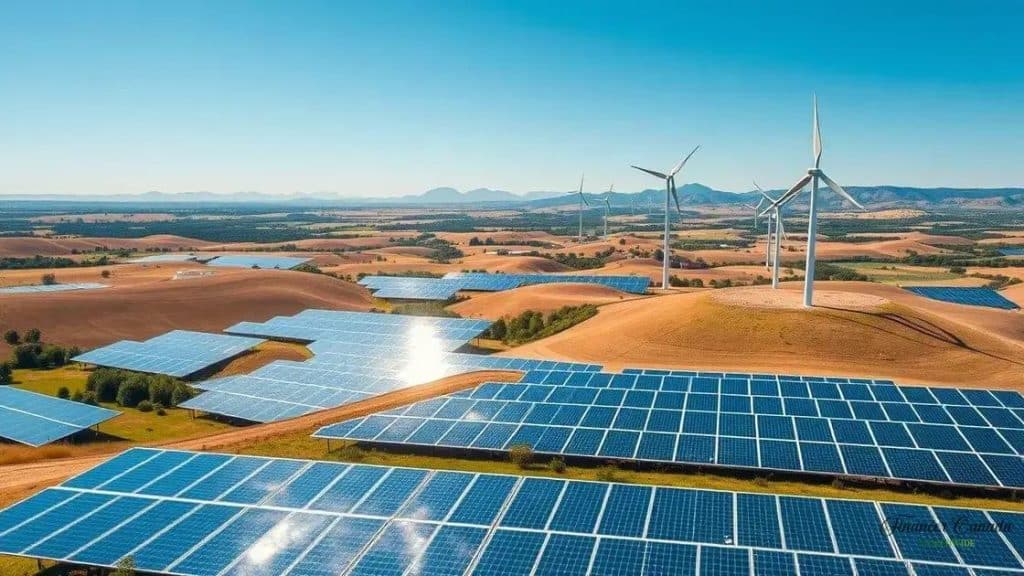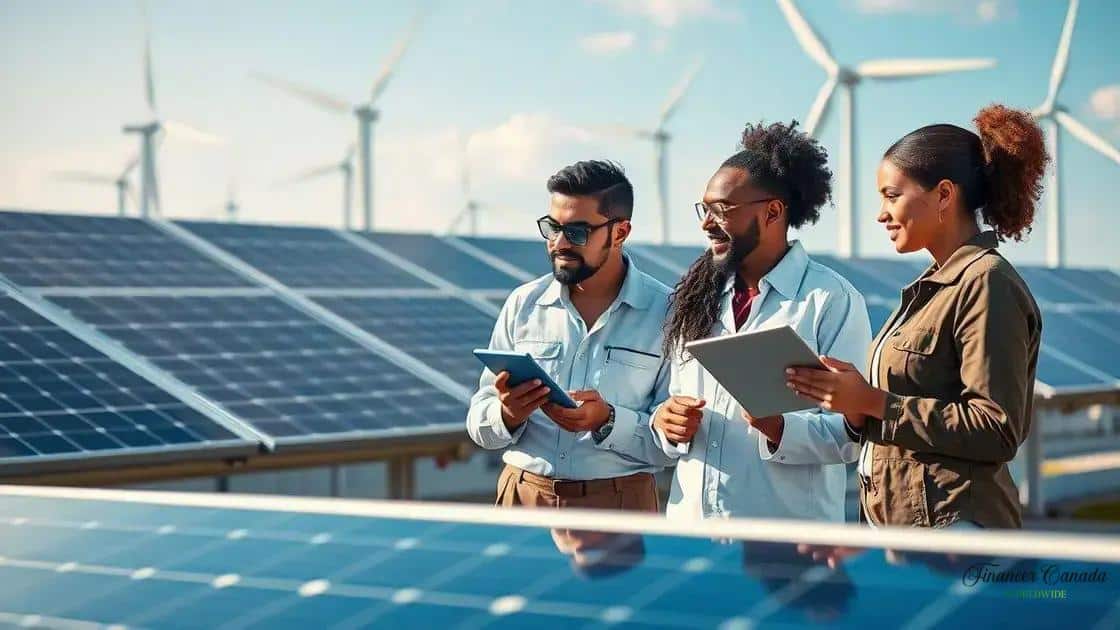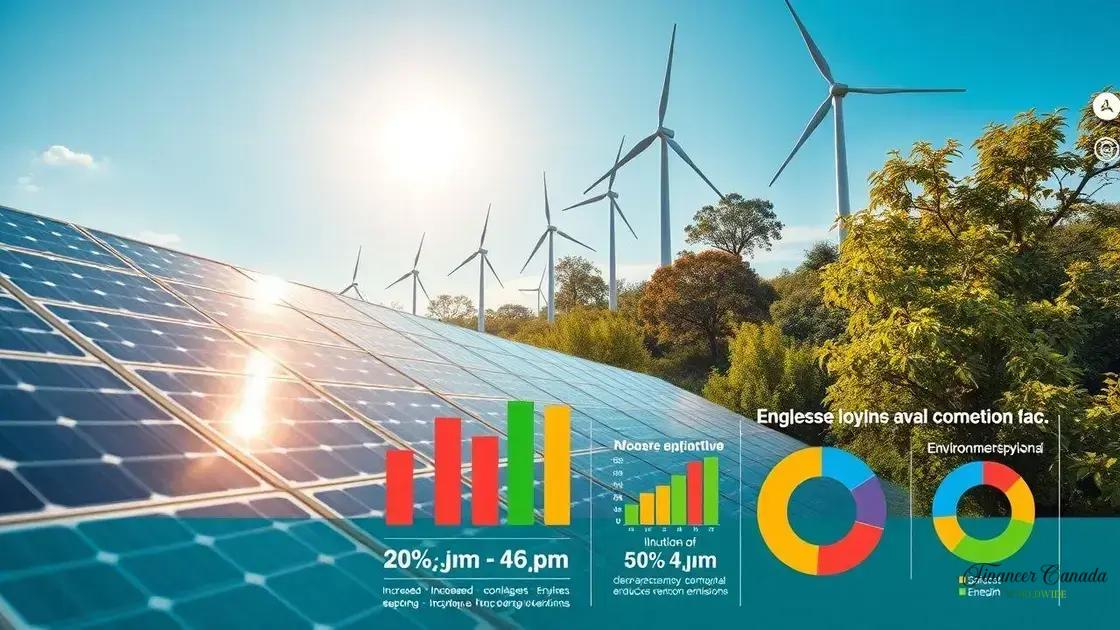Shifts in the global energy landscape towards renewables

Shifts in the global energy landscape towards renewables involve increasing investments in clean energy sources like solar and wind, driven by technological advancements and a commitment to reducing carbon emissions.
Shifts in the global energy landscape towards renewables are reshaping our environment and economy. As we embrace sustainable practices, it’s crucial to understand the implications of this transition.
Understanding the global energy transition
The global energy transition is a significant shift from traditional energy sources to renewable ones. This change is driven by the need to combat climate change and reduce dependency on fossil fuels. Understanding this transition is crucial for everyone as it affects both our environment and our daily lives.
The Importance of Renewable Energy
Renewable energy sources, such as solar, wind, and hydropower, play a vital role in a sustainable future. They help reduce carbon emissions, improve air quality, and create jobs in the green economy. By embracing these alternatives, we can make a positive impact on our planet.
- Reduction of greenhouse gases: Transitioning to renewables helps minimize harmful emissions.
- Resource sustainability: Renewable energy sources are abundant and can meet our long-term needs.
- Economic growth: The shift to green energy creates new jobs and boosts local economies.
As we explore this energy transition, we also face challenges that must be addressed. Infrastructure development, policy support, and consumer awareness are critical for a successful shift. Collaboration between governments, businesses, and communities can facilitate this change.
Challenges in the Energy Transition
While the benefits are clear, there are obstacles to overcome. Transitioning to renewable energy systems demands significant investment and technological advancements. Moreover, there is a need for widespread public understanding to ensure a smooth transition.
Technical innovations are transforming the way we harness energy. Advances in battery storage, grid management, and energy efficiency are crucial in maximizing renewable energy’s potential. By staying informed and engaged, we can all play a part in this transition.
Furthermore, understanding the global implications of this shift is essential. Countries around the world are setting goals for carbon neutrality, pushing for changes in energy production and consumption patterns. Keeping track of these changes can empower individuals to make informed choices.
The role of technology in renewable energy

Technology plays a crucial part in the evolution of renewable energy. It enhances the efficiency and effectiveness of energy production, making sustainable options more accessible and reliable. As we advance, the innovations in this field continue to shape our global energy landscape.
Innovations in Solar Power
Solar energy technology has seen rapid growth over the past decade. Photovoltaic cells convert sunlight into electricity more efficiently than ever. Additionally, innovations in solar panel design are making them more affordable and easier to install.
- Improved efficiency: New technologies have increased solar panel efficiency, allowing for more energy capture.
- Energy storage advancements: Battery technology is evolving, making it easier to store solar energy for use at night.
- Smart grid integration: Technology enables solar systems to connect efficiently to the power grid.
Wind energy is another area benefiting from technological advancements. Turbines are now taller and designed to capture wind flow more efficiently. This increases the amount of power generated and allows for placement in diverse environments.
Technological Contributions to Wind Energy
As wind technology advances, we see a decrease in costs and an increase in energy output. More sophisticated designs allow wind farms to generate energy in lower wind speeds. Additionally, offshore wind farms are becoming more common due to advancements in turbine technology.
Technological progress also helps in monitoring the performance of renewable energy systems. By using data analytics, operators can optimize energy production and address issues swiftly. Smart technology allows for real-time adjustments to maximize efficiency.
Lastly, the transition to renewable energy requires innovative solutions in energy management. Smart technologies play a significant role in balancing supply and demand, ensuring that renewable sources can meet the energy needs of communities.
Key challenges facing renewable energy adoption
Adopting renewable energy comes with its own set of challenges. Understanding these obstacles is essential for fostering a smoother transition to sustainable energy solutions. As more individuals and organizations aim to shift towards renewable systems, being aware of these hurdles can facilitate better planning and decision-making.
Financial Barriers
One of the significant challenges is the financial investment required for renewable energy projects. Initial costs for technology installation, such as solar panels or wind turbines, can be high. Many organizations may struggle to secure funding or financing, which can limit their ability to implement sustainable energy solutions.
- Limited access to capital: Not all businesses can afford the upfront costs of renewable energy technologies.
- Cost fluctuations: The volatility in pricing for renewable technologies can be a deterrent for investment.
- Long payback periods: Many renewable projects take years to become profitable, discouraging investors.
Besides financial challenges, there are technical and logistical issues that must be confronted. The integration of renewable systems into existing energy infrastructures can be complex. This requires substantial planning, coordination, and sometimes, innovative technology solutions.
Infrastructure Limitations
Many regions also face outdated infrastructure that cannot support new renewable energy sources. Upgrading this infrastructure to accommodate renewables is often needed but can be time-consuming and expensive. Additionally, inconsistent energy supply from renewables can create reliability issues that deter potential users.
Public perception and acceptance of renewable energy is another hurdle. Misunderstandings about the efficiency and reliability of these systems can lead to resistance. It is essential to educate the community about the benefits and capabilities of renewable technologies.
Finally, governmental policies and regulations play a crucial role in renewable energy adoption. In some areas, lack of supportive policies can stall progress. Developers may find it challenging to navigate the regulatory environment, which can vary greatly from one location to another.
Comparative advantages of renewable sources

Renewable energy sources offer numerous advantages compared to traditional fossil fuels. These benefits include sustainability, environmental protection, and economic growth, which make renewable sources a vital part of our energy future. Understanding these advantages can help individuals and businesses make better energy choices.
Sustainability and Resource Availability
Renewable energy sources, such as solar, wind, and hydro power, are naturally replenished. This means they will not run out as fossil fuels might. In contrast, fossil fuels are finite resources that will deplete, leading to energy insecurity and higher costs as they become scarcer.
- Unlimited supply: The sun and wind are always available; thus, solar and wind energy can be harnessed continually.
- Reduction of resource depletion: Using renewable sources prevents extensive depletion of natural resources.
- Energy independence: Developing renewable energy systems can reduce reliance on imported fuels.
Transitioning to renewables also brings significant environmental benefits. Unlike fossil fuels, renewable energy sources produce little to no greenhouse gas emissions during operation. This greatly reduces air pollution and combats climate change.
Environmental Impact
The use of renewable energy can help protect biodiversity and ecosystems by minimizing habitat destruction associated with fossil fuel extraction. Additionally, switching to clean energy sources can improve public health by reducing air and water pollution.
The economic benefits of adopting renewables are notable as well. Investments in renewable energy create jobs in manufacturing, installation, and maintenance. This sector is becoming a significant source of employment worldwide, which helps stimulate local economies.
Renewable energy systems often lead to lower operating costs over time, as they rely on free natural resources. Once the infrastructure is in place, the ongoing costs associated with renewables tend to be lower than those for fossil fuels.
Future trends in the global energy market
The global energy market is evolving rapidly, driven by shifts towards renewable energy and advancements in technology. Understanding these future trends can help stakeholders adapt and thrive in this changing environment.
Growth of Renewable Energy Sources
One of the most significant trends is the continuous growth of renewable energy sources. Governments and organizations are investing in clean energy technologies to meet climate goals. This shift is not just about reducing carbon emissions; it’s also about harnessing the economic potential of green energy.
- Increased investment: More funds are being directed towards solar, wind, and other renewables.
- Local energy production: Communities are creating localized energy systems, enhancing energy security.
- Decentralized energy systems: Consumers are becoming producers, known as prosumers, contributing to the grid.
Additionally, technology is transforming how we manage energy. Innovations in energy storage, such as batteries, are making it possible to store renewable energy for later use. This is especially crucial for balancing supply and demand, as renewable energy can be intermittent.
Technological Advancements in Energy Efficiency
Smart grids are also gaining traction. These digitally controlled systems allow for better management of energy distribution, leading to improved efficiency. With real-time data, consumers and energy providers can optimize energy use and reduce waste.
Electric vehicles (EVs) are another trend reshaping the energy market. As more individuals adopt EVs, the demand for charging infrastructure is increasing. This transition not only reduces emissions but also encourages the integration of renewable sources into transportation.
Finally, regulatory frameworks are adapting to support the growing renewable sector. Policies that promote subsidies, incentives, and carbon pricing are becoming common. These strategies aim to steer investments towards clean energy and facilitate a smoother transition away from fossil fuels.
In conclusion, the shift towards renewable energy is not just beneficial; it’s essential for the future of our planet. As we explore options like solar, wind, and other renewable sources, we see a path to sustainability and cleaner air.
However, challenges remain in adoption, financing, and technology integration. By addressing these challenges collaboratively, we can foster a more sustainable energy market. The future of energy holds great promise, driven by innovation, commitment, and community involvement.
FAQ – Frequently Asked Questions about Renewable Energy
What are the main sources of renewable energy?
The primary sources of renewable energy include solar, wind, hydro, geothermal, and biomass energy.
How does renewable energy benefit the environment?
Renewable energy reduces greenhouse gas emissions, decreases air pollution, and conserves natural resources.
What challenges are faced in adopting renewable energy?
Key challenges include financial investment, infrastructure limitations, and public acceptance.
How is technology influencing renewable energy?
Technological advancements improve energy efficiency, storage solutions, and grid management for renewables.





